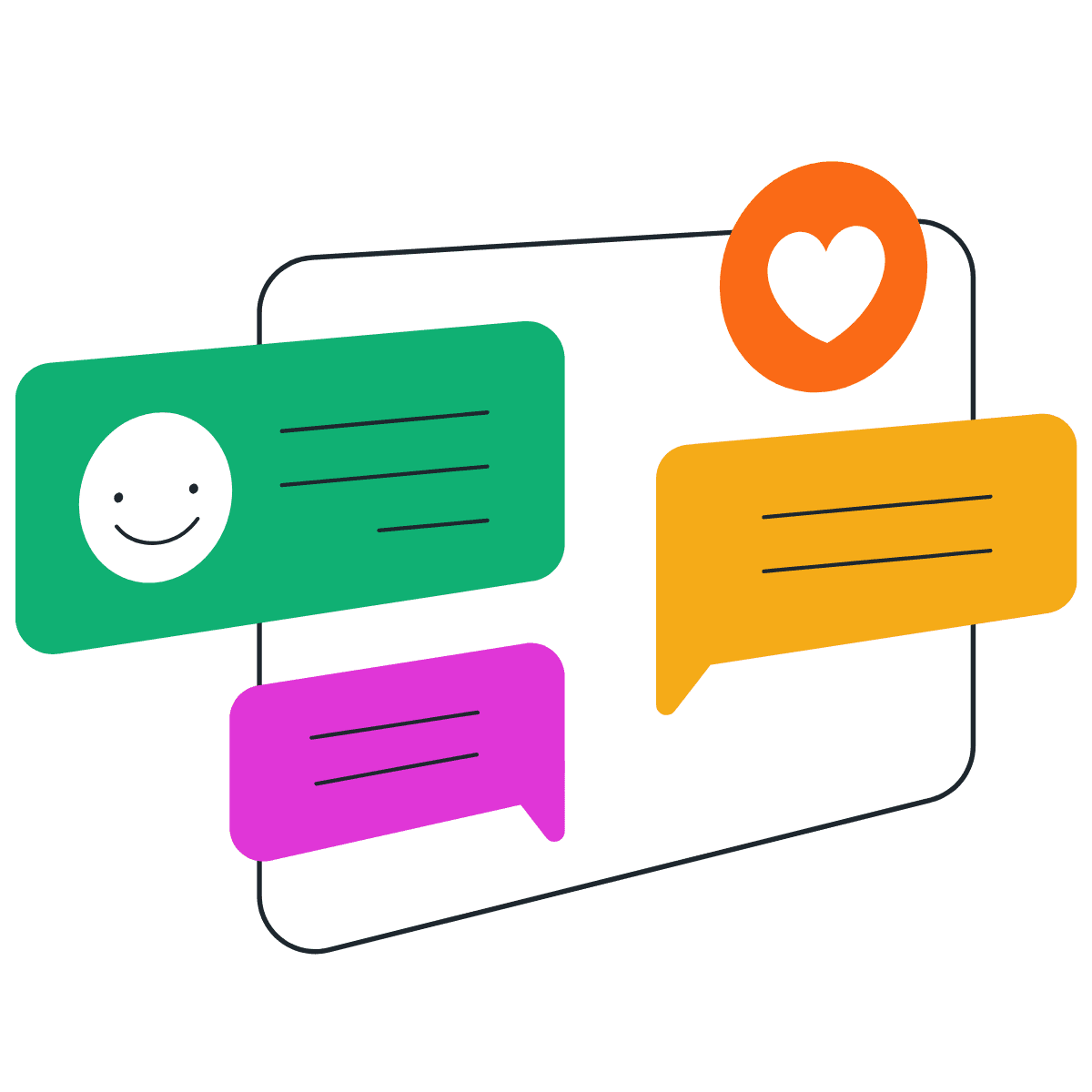A curated list of generative AI tools for content, design, and marketing workflows.
Summary Generative AI tools are transforming marketing by helping teams brainstorm, design, and scale content faster than ever. This guide breaks down the best generative AI platforms in 2025, organized by category, and explains how to choose the right tool for your marketing stack. |
Generative AI has become a core part of modern marketing workflows. From brainstorming content ideas to designing visuals and automating research, AI tools give marketers new ways to save time and scale their efforts.
With hundreds of generative AI platforms competing for attention, it’s hard to know which ones are worth your time. This guide highlights popular generative AI tools in 2025 and shows you how to pick the right platform for your marketing stack.
What are generative AI tools?
Generative AI tools are applications and platforms that create outputs, including text, images, videos, and code, in response to prompts. In marketing, they help teams turn ideas into content more quickly, adapt messaging across channels, and produce assets in a fraction of the time it once took. The result is greater efficiency, more room for experimentation, and better personalization. For background on the models powering these platforms, see LLMs vs generative AI.
Top generative AI tools list
The following list of generative AI platforms is organized by category so you can see what’s available in coding, writing, design, and more. These are among the best generative AI tools for digital marketing campaigns.
AI assistants and research
ChatGPT is OpenAI’s conversational AI and one of the most widely used generative platforms. It can draft content, answer questions, brainstorm ideas, code, and provide interactive outputs.
Claude, built by Anthropic, is designed for reliable and safe responses. It can handle long documents, code generation, and everything else ChatGPT does, which makes it especially useful for research-heavy projects.
Gemini is Google’s AI assistant integrated with Workspace and search products. It helps you generate content, analyze data, and answer queries directly inside familiar tools like Docs and Gmail.
Grok is X’s (Twitter) AI chatbot. It provides conversational and contextual responses, which makes it appealing for testing audience engagement on social media.
Perplexity is an AI search engine that delivers direct answers with citations. It’s valued for research-driven content marketing because it saves time and verifies sources.
Poe, from Quora, enables users to try multiple AI models through a single interface. It allows you to compare responses across platforms without needing to switch apps.
Pi AI is a personal assistant AI that emphasizes thoughtful conversation. It’s best suited for ideation, brainstorming, and lightweight productivity support.
Andi is a search engine powered by AI that shows answers instead of lists of links. It provides you with quick insights for campaign planning and content inspiration.
Copilot integrates AI into Microsoft Office and Windows tools. It helps with drafting, summarizing, and analyzing data in Word, Excel, Outlook, and beyond.
NotebookLM is Google’s AI-first notebook designed for research organizations. Users can upload materials and then ask contextual questions to generate summaries and insights.
Consensus is a search engine that uses AI to extract findings from academic papers. It’s valuable for marketers who want research-backed content to establish credibility.
Elicit assists with academic research and data analysis. It structures information in digestible formats so you can draw conclusions faster.
Explainpaper makes academic and technical papers easier to understand. You can use it to quickly extract plain-English explanations of complex topics.
SciSpace is a research tool that generates and explains scholarly content. It works well for data-heavy thought leadership pieces and niche reports.
ChatPDF enables users to upload PDFs and interact with them. It’s a timesaver for analyzing reports, white papers, and case studies.
Research Rabbit is a discovery and visualization platform for academic work. It helps you identify research trends and track sources relevant to your industry.
Content and copywriting
Jasper is one of the most popular AI content platforms for scaling branded writing. It helps teams produce blogs, ads, and emails more efficiently while maintaining a consistent brand voice.
Copy.ai generates marketing copy for campaigns, landing pages, and product descriptions. Its ready-made templates help teams quickly draft and test variations.
Anyword blends copywriting with predictive analytics. It forecasts how different variations will perform and helps you choose the best option before launch.
Rytr is a lightweight AI writer ideal for small teams. It’s perfect for creating short-form content, such as descriptions, captions, and quick posts.
Sudowrite supports creative writing and storytelling. You can use it to brainstorm campaign themes or refine content with more personality.
QuillBot is a tool for paraphrasing and summarizing content. It’s useful for reworking existing text into fresh formats while preserving meaning.
Notion AI is built into the Notion workspace. It generates task notes, summaries, and brainstorming ideas without disrupting project management workflows.
Mem is an AI-enhanced note-taking tool that automatically recalls context. It surfaces relevant ideas during work, which supports ongoing content creation.
Grammarly is a widely used AI-powered writing assistant that goes beyond basic grammar and spelling checks. It offers style suggestions, tone adjustments, and generative AI features that help marketers draft and refine content across emails, blogs, and social media.
Writesonic is an AI content generation platform designed to create blogs, ads, product descriptions, and landing pages. It also offers SEO-focused tools and integrations that help marketers draft long-form articles and campaign copy more efficiently.
Visual design and multimedia
MidJourney is an AI image generator that produces high-quality artwork. It’s favored for creative visuals in campaigns, ads, and brand storytelling.
DALL·E is OpenAI’s text-to-image generator, now integrated with ChatGPT. It creates custom visuals from prompts for use in content and design.
Adobe Firefly brings generative AI into Adobe’s design suite. It enhances Photoshop and Illustrator workflows with tools for image generation and editing.
Canva AI adds text, image, and video generation to Canva’s design platform. It allows non-designers to produce professional graphics at scale.
Stable Diffusion is an open-source image generation model. It offers flexibility for customization and can be run privately for sensitive projects.
Runway is an AI-powered video editing tool. It provides generative video features that marketers use for ads, social campaigns, and experimental content.
Synthesia produces AI-generated videos with avatars and voiceovers. It’s commonly used for explainer videos and training materials.
Sora is OpenAI’s text-to-video generator, currently in early development. It highlights the future potential of AI-generated video for marketing.
OpusClip repurposes long videos into short clips. Marketers use it to adapt webinars or podcasts into content tailored for social media.
Descript is an AI audio and video editor with transcription and overdub features. It enables content teams to edit media by adjusting text transcripts.
ElevenLabs specializes in realistic AI voice generation. It’s used for voiceovers in ads, podcasts, and multimedia campaigns.
Murf is an AI voiceover tool for business and marketing content. It’s valued for creating professional narration for videos and presentations.
Marketing and advertising tools
AdCreative.ai creates ads automatically, from visuals to copy. It helps you generate multiple ad variations for quick testing.
Pencil is an AI ad tool with predictive insights. It helps marketers select which ad creatives are likely to perform best.
Smartly.io automates paid media optimization. It reduces manual management for teams running large, complex ad campaigns.
Breeze is built into HubSpot’s CRM and marketing suite. It offers generative features for drafting content, engaging leads, and optimizing campaigns.
Lately AI transforms blogs and podcasts into social-ready posts. It maximizes ROI by extending the reach of high-effort content.
Ocoya merges AI writing with social scheduling. It’s designed for small teams managing multi-channel campaigns.
Drift is a conversational marketing platform that engages visitors through AI chatbots. It drives real-time conversations that convert to leads.
Intercom AI powers customer messaging with generative responses. It helps teams handle high volumes of queries efficiently.
MarketMuse is an AI-powered platform for content strategy and optimization. It helps marketers research topics, build briefs, and create content that aligns with SEO and topical authority.
Productivity and collaboration
Fathom records, transcribes, and summarizes meetings. It gives teams a searchable record of discussions to keep projects on track.
Nyota is an AI productivity assistant that blends tasks and knowledge recall. It helps professionals manage daily workflows more effectively.
Reclaim automatically optimizes calendars with AI. It schedules tasks intelligently to balance meetings and focus time.
Clockwise improves scheduling with AI-powered time blocking. It reduces conflicts and improves coordination across teams.
Shortwave is an AI email assistant that writes replies and provides summaries. It reduces time spent on inbox management.
Zapier AI brings intelligence into workflows. It triggers automations and integrates AI actions across hundreds of apps.
n8n is an open-source automation tool with AI connectors. It’s flexible for marketers who want custom workflows without closed systems.
Guru is a knowledge management tool with AI search features. It ensures teams have access to accurate information when they need it.
Web and app development
Durable is an AI website builder that generates entire sites, including copy, design, and images, in seconds from a single prompt.
10Web is a WordPress-based AI website builder that auto-generates designs and content. It’s popular for agencies and marketers who want fast, customizable builds.
Beautiful.ai is presentation software with automated slide layouts. It saves time for marketers who need professional decks on demand.
TeleportHQ is an AI-powered front-end platform that generates responsive websites and UI code from prompts. It bridges design and development by turning ideas into production-ready code.
Mixo is an AI startup website builder that creates landing pages, copy, and imagery from a single idea or product description. It’s especially popular with entrepreneurs and lean marketing teams.
Appy Pie’s AI tool generates mobile apps without coding. Users describe their app idea in natural language, and the platform builds a functional prototype.
GitHub Copilot is an AI coding assistant that predicts code. It speeds up development for technical teams working on marketing-related products.
Cursor is an AI-first code editor. It integrates generative features directly into the coding environment.
Google Cloud AI and APIs
Vertex AI Studio is Google Cloud’s development platform for AI. It supports building, training, and deploying large-scale AI projects.
AI Studio for Gemini lets users experiment with Google’s Gemini models. It’s a starting point for testing prompts and building prototypes.
The Translation API offers multilingual support at scale. It’s widely used in global campaigns to localize content.
The Natural Language API analyzes text for sentiment and entities. Developers use it to process customer feedback or reviews.
Speech-to-Text converts audio into accurate transcripts. It’s useful for podcasts, webinars, and accessibility improvements.
Video Intelligence API recognizes objects, scenes, and activities in videos. It helps teams tag and organize large media libraries.
Free generative AI tools
Many top platforms, such as ChatGPT, Claude, and Gemini, offer free tiers with limited access. These versions are useful for experimenting, but not enough for most professional marketing work. Below are truly free generative AI tools that don’t require subscriptions or credit systems.
ImageFX is a free AI image generator from Google Labs. It provides a way to test generative design without a paid plan.
MusicFX is Google’s AI music generator. It can be used to create free background music for campaigns, videos, and creative projects.
Scribble Diffusion converts sketches into images with Stable Diffusion. It’s a simple, free way to experiment with generative art.
Perchance Image Generator is a browser-based text-to-image tool. It allows unlimited usage without accounts or credits.
74. Chrome Music Lab Song Maker
Song Maker is part of Chrome Music Lab’s creative suite. It lets users compose and share music directly in the browser.
Diffit generates differentiated lesson plans and teaching materials. It helps educators tailor content for students at different levels.
MagicSchool.ai is a free AI tool for teachers. It generates assignments, quizzes, and lesson ideas for classroom use.
How to choose the right generative AI platform
With so many options, the best generative AI software depends on your specific goals and workflows. When comparing platforms, consider weighing usability, quality, and cost.
- Ease of use and integration: Look for platforms that connect with your existing stack, such as CMS, CRM, or analytics systems. Integration saves time and reduces workflow disruptions.
- Output quality and customization: Test outputs for accuracy and adaptability to ensure optimal results. The right tool should let you adjust tone, voice, or style to fit your brand.
- Pricing and accessibility: Compare free trials, subscription models, and credits. Choose a platform that provides enough value without forcing long-term commitments.
If either you or your team is new to using these types of tools, consider enrolling in free or paid generative AI courses and certifications. Industry leaders like Google and OpenAI offer free programs that can help you get up to speed quickly.
Generative AI tools as part of your marketing stack
Generative AI tools are revolutionizing digital marketing by scaling content creation and personalization. They provide opportunities to save time, expand reach, and experiment with new formats, but they still require oversight to ensure brand quality. Optimizing your website for these platforms also means understanding Generative Engine Optimization (GEO), which focuses on how AI tools parse, cite, and elevate content.
I can help your team choose, integrate, and optimize the best generative AI platforms for your stack. Contact us today for a complimentary consultation and review of your strategy.
FAQs about generative AI tools
What are examples of generative AI tools?
Generative AI tools include ChatGPT for conversational support, Jasper for copywriting, MidJourney for image creation, Canva AI for design, and Runway for video production. Marketers rely on these tools for specific tasks that enable them to quickly convert ideas into content.
What is the best free generative AI tool?
Marketers can try free tools like ImageFX, MusicFX, Scribble Diffusion, and Perchance Image Generator without paying for subscriptions. ChatGPT and Gemini also provide free tiers with usage limits. Choose between free and paid tools based on your needs: ImageFX or Scribble Diffusion for visuals, MusicFX for sound, and ChatGPT for text.
How are generative AI tools used in marketing?
Marketers use generative AI to draft blog posts, ad copy, visuals, and video content. These tools also support brainstorming, repurpose long-form assets into social posts, and personalize messages for different audiences. By automating routine creative tasks, teams can spend their time on higher-level tasks, like strategy or A/B testing.
What is the difference between generative AI and AI tools in general?
Generative AI generates new outputs, such as text, images, or audio, in response to prompts. Traditional AI tools analyze data, make predictions, or classify information, but do not create original content.
Which generative AI platforms are most popular in 2025?
Marketers in 2025 rely on ChatGPT, Claude, Gemini, Jasper, MidJourney, Canva AI, and Runway. These AI generative tools dominate because they support multiple use cases, including copywriting, design, conversational assistance, coding, and video production.







